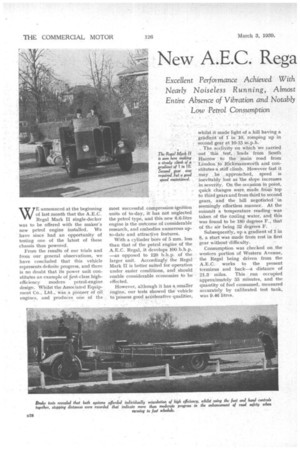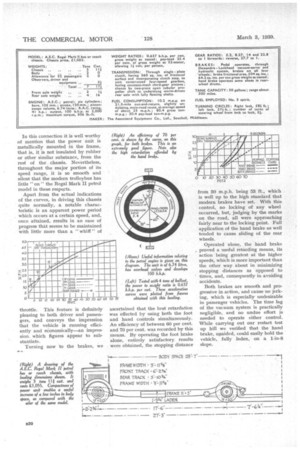New A.E.C. Rep
Page 38

Page 39

Page 40

Page 41

If you've noticed an error in this article please click here to report it so we can fix it.
Aark II Reveals All-round Efficiency
Excellent Performance Achieved With Nearly Noiseless Running, Almost Entire Absence of Vibration and Notably Low Petrol Consumption
Road Test No. 284
WE announced at the beginning of last month that the A.E.C. Regal Mark II single-decker was to be offered with the maker's new petrol engine installed. We have since had an opportunity of testing one of the latest of these chassis thus powered.
From the results of our trials and from our general observations, we have concluded that this vehicle represents definite progress, and there is no doubt that its power unit constitutes an example of ,first-class highefficiency modern petrol-engine design. Whilst the Associated Equipment Co., Ltd., Was a pioneer of oil_ engines, and produces one of the most successful compression-ignition units of to-day, it has not neglected the petrol type, and this new 6.6-1itre engine is the outcome of considerable research, and embodies numerous upto-date and attractive features.
With a cylinder bore of 5 ram. less than that of the petrol engine of the A.E.C. Regal, it develops 100 b.h.p. —as opposed to 120 b.h.p. of the larger unit. Accordingly the Regal Mark II is better suited for operation under easier conditions, and should enable considerable economies to be effected.
However, although it has a smaller engine, our tests showed the vehicle to possess good accelerative qualities,
whilst it made light of a hill having a gradient of I in-10, romping up in second gear at 10-15 m.p.h.
The acclivity on which 'we carried out this test, leads from South Harrow to the main road from London to Rickmarisworth and constitutes a stiff climb. However fast it may , be approached, speed is inevitably lost as the slope increases in severity. On the occasion in point, quick changes were, made from top to third gears and from third to second gears, and the hill negotiated in seemingly effortless manner. At the summit a temperature reading was taken of the cooling water, and this was found to be 180 degrees F., that of the air being 52 degrees F.
Subsequently, up a gradient of 1 in 8, a start was made from rest in first gear without difficulty.
Consumption was checked on the western portion of Western Avenue, the Regal being driven from the A.E.C. works to the present • terminus and back—a distance of 21.3 miles. This run occupied approximately 55 minutes, and the quantity of fuel consumed, measured accurately by calibrated test tank, was 0.46 litres. Worked out into miles per gallon these figures represent a consumption rate equivalent to 10.2 m.p.g., which is certainly satisfactory, particularly in view of the fact that the carburetter tester had a power setting —the 'standard setting, incidentally— the figures being : main jet, 170; pilot jet, 55; and choke, 34.
Further.. evidence of power is afforded by the acceleration characteristics, which are revealed in anaccompanying graph. It will be observed that 30 m.p.h. can be attained on the, level. in about 26 seconds. from standing, and that the machine, in chassis _form, is capable of a maximum speed of approximately 50 ra.p.h.
With regard to 'flexibility, the pick-up from 10 m.p.h. in top gear and froth a,fast walking pace in third gear, is reasonably quick, whilst full, or nearly full depression of the accelerator pedal at these low engine revs, results in only slight tendency to pinking or vibration. At the other extreme—namely maximum engine speed, which, in third gear, gives a road speed of about 33 m.p.h.
vibration naturally becomes apparent, but the unit would hardly ever be called upon to run at this rate in normal driving. , In this connection it is well worthy of mention that the power unit is metallically mounted in the frame, that is, it is not insulated by rubber or other similar substance, from the rest of the chassis. Nevertheless, throughout the major portion of its speed range, it is so smooth and silent that the modern trolleybus has little " on " the Regal Mark II petrol model in these respects.
Apart from the actual indications of the curves, in driving this chassis quite normally, a notable characteristic is an apparent power period which occurs at a certain speed, and, once attained, results in an ease of progress that seems to be maintained with little more than a " whiff " of throttle. This feature is definitely pleasing to both driver and passengers, and conveys the impression that the vehicle is running efficiently and economically—an impression which figures appear to substantiate.
Turning now to the brakes, we ascertained that the best retardation was effected by using both the foot and hand controls simultaneously. An efficiency of between 60 per cent. and 70 per cent, was recorded by this means. By operating the foot brake alone, entirely satisfactory results were obtained, the stopping distance from 30 m.p.h. being 53 ft., which is well up to the high standard that modern brakes have set. With this control, no locking of any wheel occurred, but, judging by the marks on the road, all were approaching fairly near to the locking point. Full application of the hand brake as well tended to cause sliding of the rear wheels.
Operated alone, the hand brake proved a useful retarding means, its action being greatest at the higher speeds, which is more important than the other way about in minimizing stopping distances as opposed to times, and, consequently in avoiding accidents.
Both brakes are smooth and progressive in action, and cause no jerking, which is especially undesirable in passenger vehicles. The time lag of the vacuum system is practically negligible, and no undue effort is needed to operate either control. While carrying out our restart test up hill we verified that the hand brake, unaided, could easily hold the vehicle, fully laden, on a 1-in-8 slope.
From the point of view of the driver, this Regal Mark II has much to recommend it. It is exceptionally easy to steer, and can be swung around small-diameter roundabouts with little effort. The steering-box ratio, however, is low, so that the driver has to do some quick hand work when cornering fast, 5i turns of the wheel giving full range.
Gear changing is easy in both directions, and the other controls are light and conveniently placed. This engine has magneto ignition, and, in addition to the automatic advanceand-retard mechanism, there is an overriding hand control. By its means a tendency to pink when accelerating with generous throttle opening—a usual characteristic of high-efficiency petrol engines—may be checked, and, by skilful use, the utmost advantage taken of the capabilities of the power unit.
As the last-named was briefly described in our issue dated February 3, there is little object in our running through its features now. How
ever, one or two points .may be mentioned.
Cylinders, crankshaft and main and big-end hearings are identical, in respect of dimensions, with those of the corresponding oil engine. The cylinders have wet liners, easily renewable, and provided with rubber sealing rings. These, at the bottoms, are duplicated, drain holes being provided in the casting to permit any water that may leak past one to escape before reaching the other. These serve a useful function, in practice, only after initial fitting of the liners, because so soon as the rubbers have settled down a single joint forms a perfect seal.
Another new feature of the engine is that the iron main casting ha.s its base face in line with the crankshaft, not below it, as in A.E.C. engines since many years ago.
Readers will note that the machine photographed to provide the accompanying chassis view has a frame of constant height throughout its length, except where it arches over the axles, whilst the chassis tested, and shown in the dimension drawing. has a . dropped end. Both types are offered, the latter enjoying considerable popularity when it is desired to equip the coach with a capacious luggage compartment at the rear.
On a Harrington-bodied vehicle we inspected, in which this locker is incorporated, the spare wheel is carried amidships, lying under the floor, and the provision made for drawing it out (through a door on the near side) struck us as noteworthy. A flexible steel strap encircles the wheel when it is home, and all that has to be done to get the wheel out is to pull the handle.
This chassis, as tried out in our hands, constitutes a fine example of the last word in high-class passenger-vehicle design. Powered by this economical petrol engine, it should attract those operators to whom the refined running of this type holds a greater appeal than do the superior m.p.g. and the other desirable attributes of the oiler.




















































































